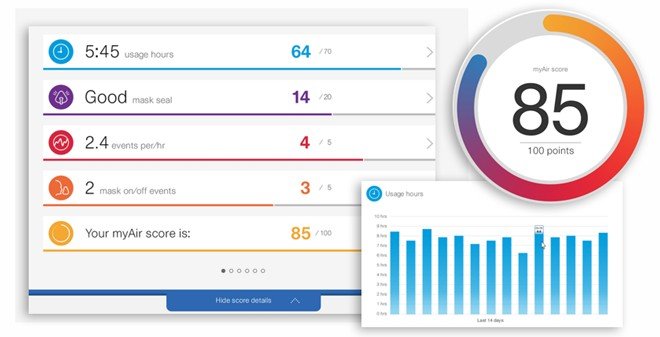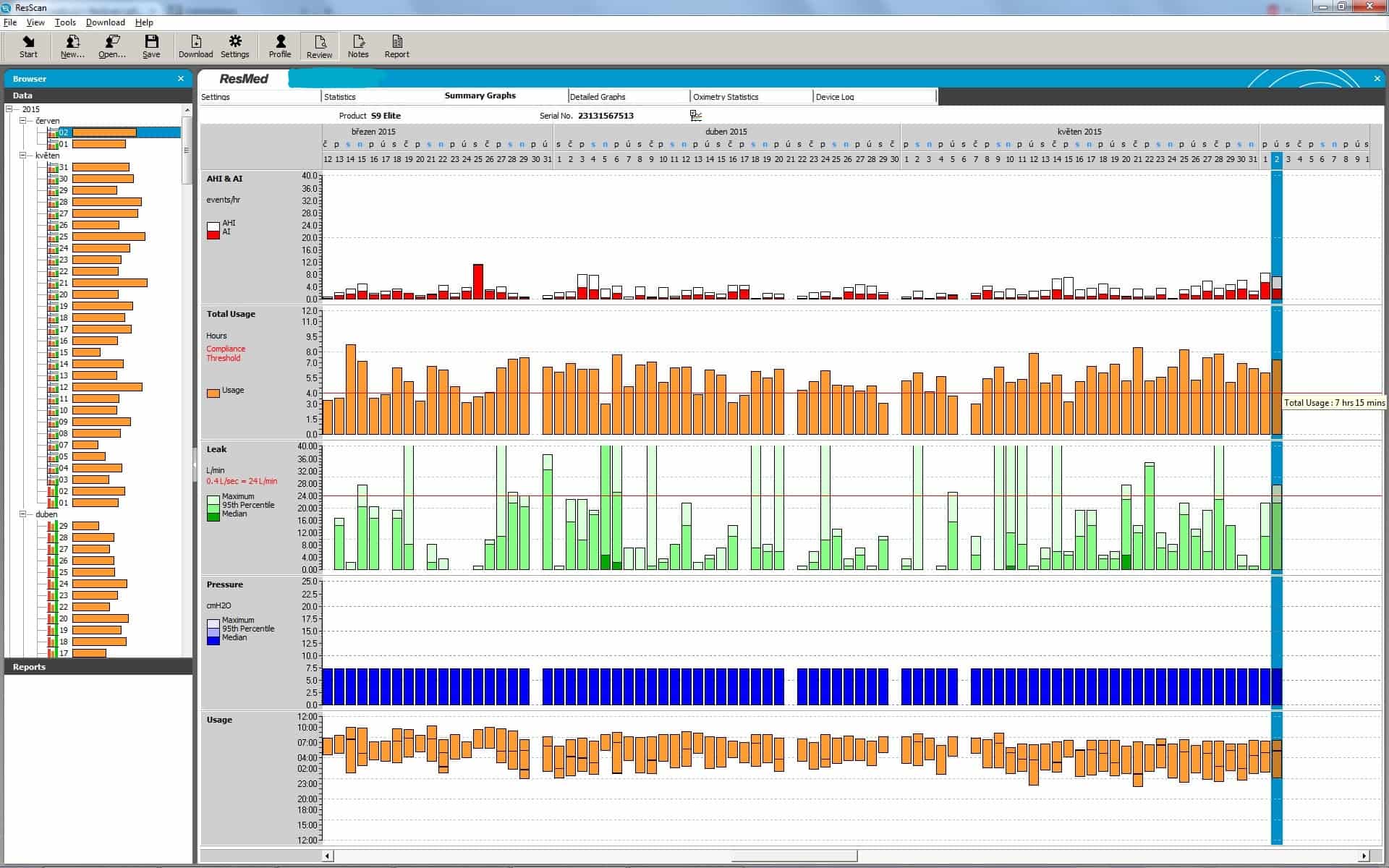– In the early days, data was transferred from the device to a computer using a cable.
– There were then chips used which meant data could be accessed without the machine present.
– Now modern machines have the ability to feed data remotely to service providers and also to the user of the device.
Why is the data useful?
The data is useful in that it helps give an indication on whether the therapy is working well. Most devices will give feedback AHI (amount of complete/partial blockages of the airway for 10 seconds or more), usage time and leak.

An example of CPAP data
What do we look for in CPAP data?
If somebody comes to us and is experiencing frustrations with their CPAP therapy, the data can often provide us with clues for what needs attention. For example, if somebody complains of noise, we will first check the leak. If the leak is high, we then probe deeper into the charts. We are trained to be able to determine whether the leak is coming from a poor sealing mask or if there is mouth leak. We can then make alterations or suggestions for different equipment based on this data.
Medical professionals also find the data useful. Typically when people are referred to be tested for sleep apnea there is a reason (fatigue, management of co-morbid illnesses etc.) Your Doctors like receiving the data as it allows them the knowledge that your sleep apnea is under control. By having this information, they can then ascertain whether your symptoms are related to sleep apnea or whether they need to investigate other issues to help you.

What data may look like
How often should I get my data checked?
With the more modern machines, you can get access to this data each day. It is a good idea to be able to give your Doctor up to date CPAP data each time you go for an appointment. Should they make changes to your medication for example, it may be of interest to them if this has had an effect on your CPAP therapy. Also, if you are going to your Doctor to discuss with them symptoms akin to Sleep Apnea (fatigue, waking tired) they will want to know whether the sleep apnea is being treated effectively as part of their investigations.
In terms of self regulating, check your data when you need to. If you are noticing something isn’t quite right, you can check the data yourself for clues or you can contact your CPAP provider who has access to more detailed information.
It is important to note if you are finding that your therapy isn’t working exactly how you would like it to or it feels uncomfortable- things can be done.

When is the data not useful?
From time to time we come across patients who get too caught up in their data. In these instances we like to remind people that we are using CPAP to help get a better sleep so our day to day lives can be enjoyed more. Our typical philosophy is to use the data to troubleshoot problems as opposed to aiming to get great scores. “Sleep to live”, not “live to sleep”.
How can I get my data checked?
Your local CPAP provider should be able to provide you with downloads upon request. If you do not have access to a local provider you can utilise our services by joining here: https://sleepright.com.au/airview/remote-monitoring-for-your-resmed-cpap-device/ or, if you are a current patient of ours and require a download, you can order one here: https://sleepright.com.au/other-services/cpap-data-report/
We can email these out to you quite rapidly and provide feedback on the data.
If you have an AirSense 10 device, Click here to see how you can self-check you sleep report.


where can i get the information on down loading and be able to understand the meanings of same .
Hi Doug, what information exactly are you after? which machine do you use?
Do I have control over who has access to my downloaded information. Eg do I have appove each person’s access to it?
In terms of viewing AirView, it will be only one CPAP provider and a Sleep Physician if you allow this. You will need to contact ResMed direct to see how they handle it on their front.
Can the data I downloaded be used for vicroads reports for my licence. I need to get a report done
Geoff, usually this will need to accompanied by a Sleep Physician letter. So typically we do a download, patient sees the Physician. Then Physician writes a letter and its all done.
I have a brand new machine unused can my partner have his details put onto a new chip and use the machine
That should work fine. I don’t think you’d need a new chip.